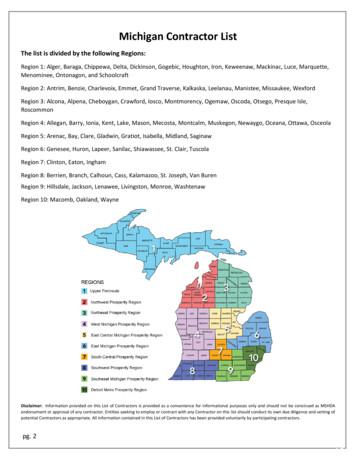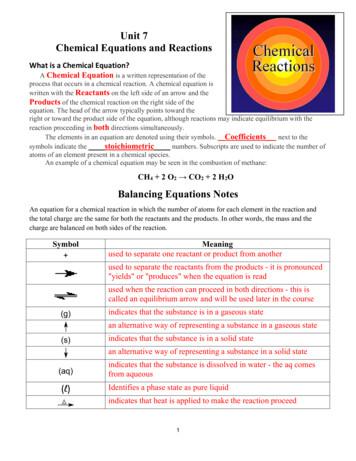Damascene Process And Chemical Mechanical Planarization
Damascene Process andChemical Mechanical PlanarizationMuhammad KhanMin Sung Kim
Background Traditionally, IC interconnects formed from Aluminum Interconnects produced by subtractive etching of blanketAluminum, defined by the photoresist pattern Over the past two decades, IC scaling and performance needsnecessitated the change in metal from Aluminum to Copper
Transition from Aluminum to Copper The primary motivation behind the transition is increaseddemand in:I.Performance Copper has lower resistivity than Aluminum Lower resistivity leads to higher performanceII.Scaling Lower resistivity leads to lower Joule Heating Allowing higher current densities and therefore smaller sizesIII. Reliability Copper has lower activation energy than Aluminum Copper is more resistive to Electromigration failures than Aluminum Copper has higher thermal conductivity, providing efficient heatconduction paths
Challenges with CopperI.Difficult to pattern using conventional etching techniques Copper does not produce a volatile by-product duringetching For example, Chlorine gas (used to etch metals in plasmaetchers) forms chloride that will not readily evaporateII.Junction spiking/Copper Poisoning Quickly diffuses into oxides and silicon Spikes could be long enough to penetrate through junctionIII. Poor oxidation/corrosion resistance Quickly oxidizes in air and does not protect the underlyingcopper from further oxidation
Solution In 1990s, IBM introduces Damascene Process A means for forming copper IC interconnects Damascene Process – a unique additive processing technique Reminiscent of the metal inlay techniques used in the MiddleEast since the middle ages. The name originates in Damascus, the capital of modernSyria
Damascene Process Addresses the challenges copper presents by: Eliminating the need to etch copper Uses Chemical Mechanical Planarization (CMP) instead of etching Using special barrier layers to stop copper diffusion Barrier layers prevent the intermixing of materials above and below thebarrier Typical barrier materials are Ta,TaN, TiN, and TiWFig. 1: Barrier Layer [1]
Damascene Process Steps Damascene is an additive process Firstly, the dielectric is deposited Secondly, the dielectric is etched according to the definedphotoresist pattern, and then barrier layer is deposited Thirdly, copper is deposited Optimum way of copper deposition is electroplating Copper electrodeposition is a two step process First seed layer is deposited on the wafer using PVD Next the copper is electroplated Finally, the surface is planarized using CMP
Etch andDepositBarrier LayerElectroplatingDepositSeed LayerCMPFig. 2: Single DamasceneProcess Steps [1]
Conventional Metallization Processversus Damascene ProcessDepositing metal anddefining PR patternMetal is etchedaccording to PR patternDepositing dielectricand defining PR patternTrenches for vias andlines are etchedMetal fills the trenchesDielectric is depositedExcess dielectric isetchedExcess metal isremoved by CMPDielectric isre-depositedFig. 3 : Comparison of conventional metallization process with Damascene Process [2]
Dual Damascene Process Very similar to single damascene process, key difference is “dual”Creates vias and lines by etching holes and trenches in thedielectric, and then depositing copper in both featuresOne photo/etch step to make holes (vias) in the dielectric soas to make connection with underlying metalSecond photo/etch step to make trenches for the metal lineThe two photo/etch steps can be performed in two orders:i.ii.Trench First then ViaVia First then Trench
Fig. 4: Trench Firstthen Trench [4]
Fig. 5: Via Firstthen Trench [4]
Challenges with Dual DamasceneProcess Via first then Trench approach Residual photoresist remains in the bottom of the via during thetrench etch Due to highly porous nature of low-K dielectrics, the residual photoresistis absorbed, thereby altering the K value of dielectric Trench first then Via approach Photoresist also pools in the open trench structure prior to viapatterning Most low-K dielectric films are hydrophilic It is critical that surface hard mask (Photoresist) shield thedielectric from moisture as well as protect dielectric fromaggressive cleans
Chemical Mechanical Polishing/Planarization- CMP is a process ofsmoothing surfaces with thecombination of chemicaland mechanical forces. Figure 6. Basic design of CMP [5].Typical Process Conditions Pressure: 2 to 7 psi Temperature: 10 C to 70 C Platen/Carrier rpm: 20 to 80 Slurry flow rate: 100 to 200mL/min Typical removal rates: Oxide CMP 2800Å/minMetal CMP 3500Å/min
How CMP worksFigure 7. Mechanical Aspects of Material Removal [6].dz: Material Removal RatedtpK : Preston Coefficientdz K P V dt[Preston’s Equation, 1927]pP PressureV Velocity
Advantages of CMP Good selectivity (No lapping) Reduce resist thickness variation Better resolution of photolithographic process by reducing depthof focus Multi-level structures Improved step coverage of subsequent layer depositionFigure 8. Oxide Planarization [5].
Advantages of CMP cont.LappingFigure 9. Better selectivity of CMP [6].CMP
Advantages of CMP cont.Lithography: Resolution Depth of FocusSi substrateCMPSi substrateFigure 10. Effect of CMP on photolithography resolution [6].
Types of PlanarizationFigure 11. Various forms of planarization [7].
Limitations of CMP Dishing and erosion Stress cracking Scratching Corrosive attacks from slurry chemicals Time-consuming Expensive
Limitations of CMP cont. Dishing and erosion are formsof local planarization wheresome areas of wafer polish fasterthan the other.Figure 12. Illustration of copper dishing andoxide erosion [7].
Multi-million machine (Nikon) Dry in Dry out 4 polishing tables Max. potential throughput of 2,000 wafers/dayFigure 13. Nikon CMP machine [6].Figure 14. E550 Alpsitec Company machine [5].
Questions
References[1] Richard et al., “Demystifying Chipmaking”, Elsevier, 2005.[2] Robert Doering and Yoshio Nishi, Eds., “Handbook ofSemiconductor Manufacturing Technology”, 2nd ed., CRC Press,2007.[3] Michael Quirk and Julian Serda, “Semiconductor ManufacturingTechnology”, 1st ed., Prentice Hall, 2000.[4] San Jose University Engineering Department, “CopperDeposition”, [Online], Available: Notes/Copper%20and%20Damascene S.pdf [Accessed: 17 Oct. 2011]
References[5] Alpsitec SARL. “Alpsitec is represented by Crystec TechnologyTrading GmbH,” http://www.crystec.com/alpovere.htm.[6] Joshua Chien, University of California Berkeley, CA,Chemical Mechanical Planarization. [Microsoft PowerPoint].Berkeley, CA: Rohm & Haas.[7] Jeffrey Rockwell and Yuzhuo Li, “Chemical MechanicalPolishing,” rockwell/rockwell.htm.
Oct 17, 2011 · Temperature: 10 C to 70 C Platen/Carrier rpm: 20 to 80 Slurry flow rate: 100 to 200 mL/min Typical removal rates: Oxide CMP 2800Å/min Metal CMP 3500Å/min -CMP is a process of smoothing surfaces with the combination of chemical and mechanical forces. Figure 6. Basic design of CMP [5].
Dual Damascene BEOL processing using multilevel step and flash imprint lithography Brook H. Chao 1, Frank Palmieri 1, Wei-Lun Jen 1, D. Hale McMichael 1, C. Grant Willson 1, Jordan Owens 2, Rich Berger 2, Ken Sotoodeh 2, Bruce Wilks 2, Joseph Pham 2, Ronald Carpio 2, Ed LaBelle 2, and Jeff Wetzel 2, 1 The
Lemon Grass (Cymbopogon Citratus) R7 777.78 Lemon balm (Melissa officinalis) - Lippia (Lippia javanica) - Rose Damascene (Rosa Damascene) - Source: Institute of Natural Resources Table 2 indicates differ
Chemical Formulas and Equations continued How Are Chemical Formulas Used to Write Chemical Equations? Scientists use chemical equations to describe reac-tions. A chemical equation uses chemical symbols and formulas as a short way to show what happens in a chemical reaction. A chemical equation shows that atoms are only rearranged in a chemical .
Levenspiel (2004, p. iii) has given a concise and apt description of chemical reaction engineering (CRE): Chemical reaction engineering is that engineering activity concerned with the ex-ploitation of chemical reactions on a commercial scale. Its goal is the successful design and operation of chemical reactors, and probably more than any other ac-File Size: 344KBPage Count: 56Explore further(PDF) Chemical Reaction Engineering, 3rd Edition by Octave .www.academia.edu(PDF) Elements of Chemical Reaction Engineering Fifth .www.academia.eduIntroduction to Chemical Engineering: Chemical Reaction .ethz.chFundamentals of Chemical Reactor Theory1www.seas.ucla.eduRecommended to you b
Mechanical Contractor Redmon Heating & Cooling Grandville (616) 534-9330 Mechanical Contractor D.K.S. Mechanical, Inc. Marne (616) 677-6001 Mechanical Contractor AirFlow Mechanical Services LLC Wyoming (616) 752-0320 Mechanical Contractor Van Antwerp's Mechanical, Inc. Holland (616) 772-1112 Mechanical Contractor Grand Rapids Heating and .
sition and tools for chemical mechanical polishing (CMP). Plating tools, both for electroplating and for electroless plating, are described in detail emphasizing their relation to the damascene process as applied for ULSI applications, i.e., material properties and integration in the manufacturing line.
Chemical Equations and Reactions What is a Chemical Equation? A Chemical Equation is a written representation of the process that occurs in a chemical reaction. A chemical equation is written with the Reactants on the left side of an arrow and the Products of the chemical
Accounting terminology Financial statement preparation Financial statement relationships 1, 2 Classifying balance sheet 1, 2 Analysis accounts CHAPTER 5 THE ACCOUNTING CYCLE: REPORTING FINANCIAL RESULTS Topic Skills Learning Balancing the accounting equation 1, 2 OVERVIEW OF BRIEF EXERCISES, EXERCISES, PROBLEMS AND CRITICAL THINKING CASES Objectives Analysis Analysis Analysis, communication .























